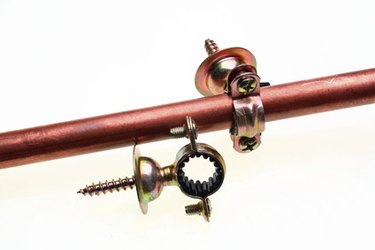Things You'll Need
1/2-inch inner diameter copper pipe, 16 inches long
1/2-inch diameter wood dowel, 24 inches long
Sandpaper
Straight edge
Dry-erase marker
Measuring tape
Drill press
3/8-inch drill bit
1/4-inch drill bit
File
Cork
Rag

Making musical instruments can be an educational project for child or adult do-it-yourselfers. A copper flute may not have all of the tonal qualities of a professionally designed instrument, but it can provide plenty of musical fun. Learning to play your copper flute may take time if you are not already a flute player. It will be easiest to get a sound with all of the holes closed (covered by your fingers) until you learn how to blow across the mouth hole properly. Practice on a real flute or by blowing across a half-empty soda bottle, as the lower pitch of these items can be easier to produce for beginners.
Step 1
Place a dowel inside your copper pipe to ensure it holds its round shape as you drill into it. If the dowel doesn't fit well, sand down its entire surface with sandpaper until it slides inside the copper. Hard copper tubing is best, rather than softer copper such as refrigerator tubing.
Video of the Day
Step 2
Hold a straight edge along the length of your copper tube and draw a line from one end to the other. All of your holes will be along this line.
Step 3
Measure 3 inches down from one end of the tube and make a small "X" on your line. Make more "X" marks at 8, 9, 10, 12, 13 and 14 inches down along the pipe.
Step 4
Place a 3/8-inch bit in your drill press and line up the bit with the "X" you made 3 inches from the end. Drill out the hole completely, allowing the bit to drill into the wood but not out the other side of the pipe. This is the mouth hole for your flute.
Step 5
Replace the 3/8-inch bit with a 1/4-inch bit and drill out the rest of your holes. These are your finger holes.
Step 6
File down any sharp edges of the copper with a round or semi-round file.
Step 7
Press a cork into the end of the copper pipe nearest the mouth hole. Make sure the cork seals the opening entirely.
Step 8

Wipe off any remaining marker with a rag. To play your flute, rest your bottom lip on the edge of the mouth hole and cover the finger holes with your first, middle and ring fingers of each hand. Uncover different holes to change the pitch.
Video of the Day